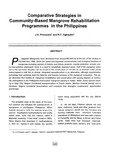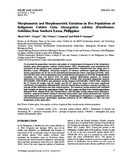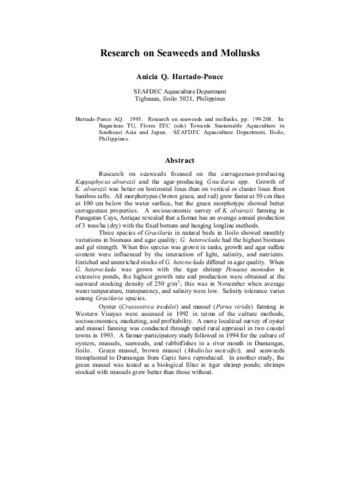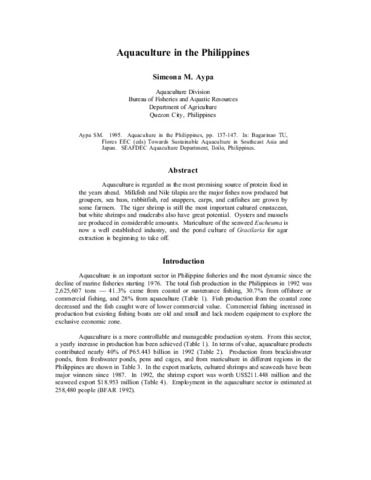Comparative strategies in community-based mangrove rehabilitation programs in the Philippines
Share
Abstract
Philippine Mangroves have decreased from around 500,000 ha at the turn of the century to 132,000 ha in 1990. Given the varied and important socioeconomic and ecological functions of mangroves including harvest of forestry and fishery products, coastal protection, erosion control and pollution abatement, there is a need to rehabilitate degraded areas. Half of the mangrove areas lost in the las three decades can be traced to the construction of 141'000 ha of brackish water ponds monocropped to mik fish or shrimp. Integrated aquasilviculture is an alternative, although experimental, technology that combines both the fisheries and forestry functions of the mangrove ecosystem.This paper describes four models of mangrove rehabilitation and conservation with varying degrees of community participation in the philippines-monoculture mangrove planting in Kalibo, Aklan; mixed species planting in Silay City, Negros Occidental; aquasilviculture in Puerto Galera, Mindoro Oriental (family) and in Hinobaan, Negros Occidental (association)- and compares their strengths, weaknesses, opportunities and threats.
Suggested Citation
Primavera, J. H., & Agbayani, R. F. (1997). Comparative strategies in community-based mangrove rehabilitation programs in the Philippines. In N. H. Phan, N. Ishwaran, T. S. Hoang, H. T. Nguyen, & S. T. Mai (Eds.), Community Participation in Conservation, Sustainable Use and Rehabilitation of Mangroves in Southeast Asia. Proceedings of the ECOTONE V, 8-12 January 1996, Ho Chi Minh City, Vietnam (pp. 229–243). Hanoi, Vietnam: United Nations Educational Scientific and Cultural Organisation; Japanese Man and the Biosphere National Committee; Mangrove Ecosystem Research Centre.
Subject
Collections
Related items
Showing items related by title, author, creator and subject.
-
Morphometric and morphomeristic variations in five populations of indigenous Celebes goby Glossogobius celebius (Perciformes: Gobiidae) from Southern Luzon, Philippines
Corpuz, Mark Nell C.; Camacho, Ma. Vivian C.; Ocampo, Pablo P. (College of Agriculture, University of the Philippines Los Baños, 2013)To elucidate the population structure and pattern of morphological divergence of the indigenous Celebes goby Glossogobius celebius (Valenciennes, 1837), morphometric and morphomeristic characters of this species were ... -
Research on seaweeds and mollusks
Hurtado-Ponce, Anicia Q. (Aquaculture Department, Southeast Asian Fisheries Development Center, 1995)Research on seaweeds focused on the carrageenan-producing Kappaphycus alvarezii and the agar-producing Gracilaria spp. Growth of K. alvarezii was better on horizontal lines than on vertical or cluster lines from bamboo ... -
Aquaculture in the Philippines
Aypa, Simeona M. (Aquaculture Department, Southeast Asian Fisheries Development Center, 1995)Aquaculture is regarded as the most promising source of protein food in the years ahead. Milkfish and Nile tilapia are the major fishes now produced but groupers, sea bass, rabbitfish, red snappers, carps, and catfishes ...




